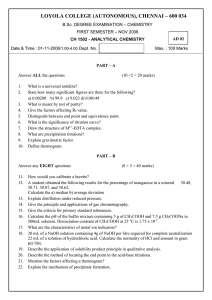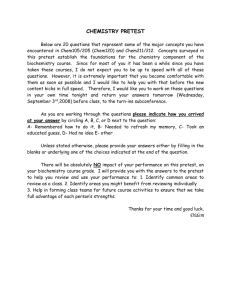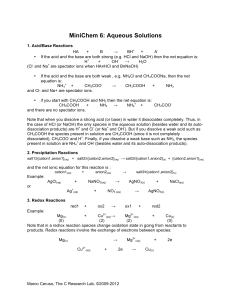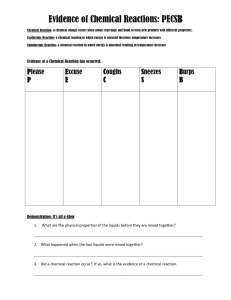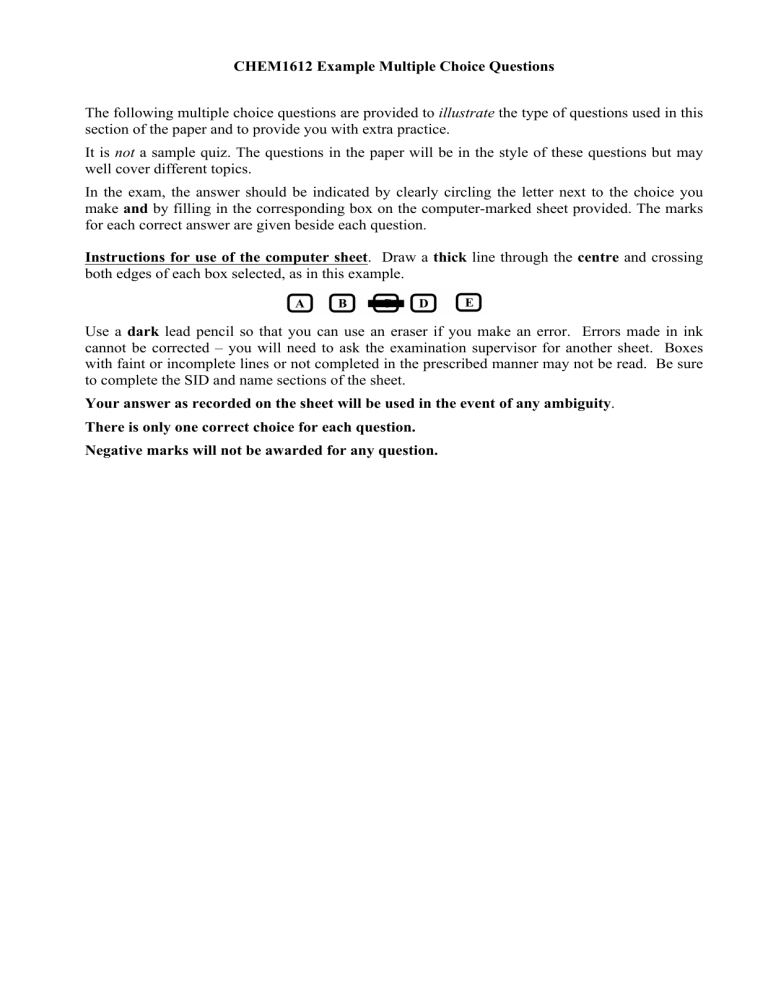
CHEM1612 Example Multiple Choice Questions The following multiple choice questions are provided to illustrate the type of questions used in this section of the paper and to provide you with extra practice. It is not a sample quiz. The questions in the paper will be in the style of these questions but may well cover different topics. In the exam, the answer should be indicated by clearly circling the letter next to the choice you make and by filling in the corresponding box on the computer-marked sheet provided. The marks for each correct answer are given beside each question. Instructions for use of the computer sheet. Draw a thick line through the centre and crossing both edges of each box selected, as in this example. Use a dark lead pencil so that you can use an eraser if you make an error. Errors made in ink cannot be corrected – you will need to ask the examination supervisor for another sheet. Boxes with faint or incomplete lines or not completed in the prescribed manner may not be read. Be sure to complete the SID and name sections of the sheet. Your answer as recorded on the sheet will be used in the event of any ambiguity. There is only one correct choice for each question. Negative marks will not be awarded for any question. CHEM1612 1. 2. 3. 4. 5. November 2008 Example Multiple Choice Questions Which statement correctly describes Hess's Law? A The enthalpy of all reactants in their standard states is defined as zero. B Enthalpy changes may only be calculated if one or more of the reactants is an element. C The enthalpy change of a reaction is independent of the route taken. D The enthalpy change of a reaction may only be calculated at 1 atm pressure and 25 °C. E Exothermic reactions occur quickly, endothermic reactions occur slowly. Which one of the following statements best describes the standard enthalpy of formation of any element? A The value of ΔH°f(element) depends on temperature. B The value of ΔH°f(element) is zero only for elements in the solid state. C The value of ΔH°f(element) is zero for any element in the standard state. D The value of ΔH°f(element) is zero only at absolute zero temperature. E The value of ΔH°f(element) depends on S° for that element. Under which circumstances would a reaction be non-spontaneous at all temperatures? A ΔH° negative and ΔS° positive B ΔH° negative and ΔS° negative C ΔH° positive and ΔS° negative D ΔH° positive and ΔS° positive E It is impossible to tell without calculating ΔG°. In which direction will the following equilibrium shift if a solution of CH3CO2Na is added? CH3COOH(aq) CH3CO2–(aq) + H+(aq) A shift to the right (more products) B shift to the left (more reactant) C no change D cannot be predicted In which of the following acid / base titrations, can we NOT determine the equivalence point in an accurate manner? A strong acid / strong base B strong acid / weak base C weak acid / strong base D weak acid / weak base Marks 1 1 1 1 1 CHEM1612 6. 7. November 2008 Example Multiple Choice Questions Marks What is the expression for Ka for the following reaction? 1 – + CH3COOH(aq) CH3CO2 (aq) + H (aq) A Ka = [CH3CO2–(aq)][H+(aq)]/[CH3COOH(aq)] B Ka = 2[H+(aq)]/[CH3COOH(aq)] C Ka = [H+(aq)]2/[CH3COOH(aq)] D Ka = [CH3COOH(aq)]/[H+(aq)]2 Rank the following 1 M water solutions in order of decreasing freezing point. NaCl glucose CaCl2 highest freezing point 8. CH3COOH 1 Na3PO4 lowest freezing point A NaCl > glucose > CaCl2 > CH3COOH > Na3PO4 B glucose > NaCl > CaCl2 > CH3COOH > Na3PO4 C glucose > NaCl > CH3COOH > CaCl2 > Na3PO4 D glucose > NaCl > CH3COOH > Na3PO4 > CaCl2 E glucose > CH3COOH > NaCl > CaCl2 > Na3PO4 Arrange the following species from left to right in order of increasing radius. 1 Na, Mg, F–, Na+, Mg2+ 9. 10. A F– < Mg2+ < Na+ < Mg < Na B Na+ < Mg2+ < F– < Mg < Na C Na+ < Mg2+ < F– < Na < Mg D Mg2+ < Na+ < F– < Mg < Na E Mg2+ < Mg < Na+ < Na < F– What is the [OH–] of a solution with a pH of 9.0? A 1 × 10–5 M B 1 × 10–9 M C 1 × 10–4 M D 1 × 10–7 M E none of the above Which of the following statements regarding the solubility of Mg(OH)2 is correct? A pH has no effect on the solubility of Mg(OH)2. B Mg(OH)2 is less soluble at pH 4 than pH 7. C Mg(OH)2 is less soluble in 0.1 M MgCl2 solution than in water. D all of the above E none of the above 1 1 CHEM1612 11. 12. November 2008 Example Multiple Choice Questions When cells are placed into an isotonic solution (i.e. the solution and cell fluid have Marks 1 the same osmotic pressure): A no exchange of water across the cell membrane occurs. B water enters the cell faster than it leaves the cell. C water leaves the cell faster than it enters the cell. D water enters the cell at the same rate that it leaves the cell. E ready exchange of solutes, but not water, occurs across the cell membrane. What is the relationship between Kc and Kp for the following reaction? A(g) + B(g) 13. A Kp = Kc(RT/100)2 B Kc = Kp(RT/100)2 C Kc = Kp D Kc = √Kp E Kc = KpRT/100 2C(g) Histidine is an amino acid. The fully protonated form has the pKa values indicated below. pKa = 5.97 H N NH CH2 pKa = 1.82 HOOC C pKa = 9.17 NH3 H Which one of the following is the predominant structure at pH 7.6? H N N N NH NH CH2 HOOC C H NH CH2 NH3 O2C A C H CH2 NH3 O2C B H N N NH NH CH2 CH2 HOOC C H D NH3 1 HOOC C H E NH2 C H C NH3 2 CHEM1612 14. November 2008 Example Multiple Choice Questions Marks Arrange the following 1 M solutions in order of increasing pH. 1 HCl KOH CaCl2 CH3COOH Na3PO4 A KOH < CaCl2 < Na3PO4 < CH3COOH < HCl B HCl < CaCl2 < CH3COOH < KOH < Na3PO4 C CH3COOH < HCl < CaCl2 < KOH < Na3PO4 D HCl < CH3COOH < Na3PO4 < CaCl2 < KOH E HCl < CH3COOH < CaCl2 < Na3PO4 < KOH In answering questions 15-19, consider the following titration curve. 12 10 8 pH 6 4 2 10 20 30 40 50 Amount of solution added (mL) 15. 16. Which one of the following combinations does the titration curve represent? A Addition of a strong base to a weak acid B Addition of a weak base to a strong acid C Addition of a strong acid to a weak base D Addition of a weak acid to a strong base E Addition of a strong acid to a strong base What is the value of the pKa that can be obtained from this titration curve? A 11.3 17. C 9.3 D 5.3 B 10.0 C 9.3 D 5.3 1 E 1.8 1 What is the pH of the solution at the equivalence point? A 11.3 B 10.0 C 9.3 D 5.3 1 E 1.8 What is the pH of the solution at the point of maximum buffering? A 11.3 18. B 10.0 1 E 1.8 CHEM1612 19. 20. 21. 22. 23. November 2008 Example Multiple Choice Questions Marks Which one of the following indicators would be most suitable for this titration? 1 A any acid/base indicator is suitable B phenolphthalein (pKa = 9.6) C cresol red (pKa = 8.3) D methyl red (pKa = 5.1) E methyl yellow (pKa = 3.1) How many stereoisomers are possible for the complex [NiCl2(en)2]? en = ethylenediamine = NH2CH2CH2NH2 A 1 B 2 C 3 D 4 E 6 How many stereoisomers are possible for the complex [Ni(en)3]2+? en = ethylenediamine = NH2CH2CH2NH2 A 1 B 2 C 3 D 4 E 6 What is the solubility constant expression for Zn3(PO4)2? A Ksp = [Zn2+][PO43–] B Ksp = [Zn2+][2PO43–] C Ksp = [Zn2+]3[PO43–]2 D Ksp = [3Zn2+]3[2PO43–]2 E Ksp = [Zn3+]2[PO42–]3 What is the solubility product constant expression for Ag3PO4? A Ksp = [Ag+][PO43–] B Ksp = [Ag+][PO43–]3 C Ksp = [Ag+]3[PO43–] D Ksp = [3Ag+]3[PO43–] E Ksp = 3[Ag+][PO43–] 1 1 1 1 CHEM1612 24. 25. 26. November 2008 Example Multiple Choice Questions Marks How would the concentration of Pb2+(aq) ions in equilibrium with PbI2(s) be 1 affected if the concentration of I–(aq) ions were doubled? A no change B increased by a factor of 2 C decreased by a factor of 2 D decreased by a factor of 4 E decreased by a factor of 16 Which one of the following is a coordination isomer of the complex salt, trans-[CrCl2(OH2)4]Br? A cis-[CrCl2(OH2)4]Br B trans-[CrBrCl(OH2)4]Cl C cis-[CrBr2(OH2)4]Cl D trans-[CrBr2(OH2)4]Cl E trans-[Cr(OH2)4Cl2]Br Which one of the following equations describes the enthalpy of combustion of glucose. A C6H12O6(s) → 6C(s) + 6H2O(l) B C6H12O6(s) → 2C2H5OH(l) + 2CO2(g) C C6H12O6(s) → 6C(s) + 3O2(g) + 6H2(g) D C6H12O6(s) + 3O2(g) → 6CO2(g) + 6H2(g) E C6H12O6(s) + 6O2(g) → 6CO2(g) + 6H2O(g) Questions 27 - 30 refer to the voltaic cell shown below. Voltmeter Ni Salt Bridge Cu 1.0 M Cu2+ 2+ 1.0 M Ni 1 1 CHEM1612 27. 28. 29. 30. 31. November 2008 What is the overall reaction occurring in this cell? A There will be no spontaneous reaction. B Ni2+(aq) + Cu(s) → Ni(s) + Cu2+(aq) C Cu2+(aq) + Ni(s) → Cu(s) + Ni2+(aq) D Cu2+(aq) + Ni2+(aq) + 4e– → Cu(s) + Ni(s) E Cu(s) + Ni(s) → Cu2+(aq) + Ni2+(aq) + 4e– Example Multiple Choice Questions Marks 1 What would be the value of Ecell at equilibrium? A 0.58 V B 0.34 V C 0.24 V D 0.10 V E 0.00 V What is the reading on the voltmeter when the half cells are first connected? A 0.58 V B 0.34 V C 0.24 V D 0.10 V E 0.00 V Which electrode is the anode and to which electrode do the electrons flow? A The Ni electrode is the anode; electrons flow to the cathode. B The Cu electrode is the anode; electrons flow to the cathode. C The Ni electrode is the anode; electrons flow to the anode. D The Cu electrode is the anode; electrons flow to the anode Rank the following series of atoms in order of INCREASING electronegativity. N A N < O < F < P < As B F < O < N < P < As C As < P < N < O < F D As < P < N < F < O E F < N < O < As < P O F P As 1 1 1 1 CHEM1612 32. November 2008 Example Multiple Choice Questions Marks A reaction has an activation energy of 40 kJ mol–1 and an overall energy change 1 of –100 kJ mol–1. In each of the potential energy diagrams shown below, the horizontal axis is the reaction coordinate and the vertical axis is potential energy in kJ mol–1. Which potential energy diagram best describes this reaction? 40 A 40 B 100 reactants products 40 100 reactants products 100 C reactants products 40 D E 100 100 40 reactants 33. products 35. products What is the missing particle for the following nuclear decay process? 137 55 34. reactants A 1 0 B 0 1 C 0 −1 D 0 −1 E 0 1 Cs → 137 56 1 Ba + ? n α α β β What isotope is produced by the α-decay of A 222 85 At B 218 84 Po C 218 88 Rn D 222 87 Fr E 221 85 At 222 86 Rn ? Which one of the following statements about reaction rate is false? A Reaction rate is the speed at which the reaction proceeds. B Reaction rate is governed by the energy barrier between reactants and products. C Enzymes can accelerate the rate of a reaction. D Reaction rates are not sensitive to temperature. 1 1 CHEM1612 36. 37. 38. 39. 40. November 2008 What isotope is produced by the α-decay of A None - B 99 42 Mo C 95 41 Nb D 99 44 Ru E 103 45 Example Multiple Choice Questions 99 43 Tc ? Tc undergoes β– decay Rh A +I B +III C +VI D 0 E –III What is the oxidation state of Tc in K2[TcO(ox)2]? ox is the oxalate anion, C2O42–. A +II B +III C +IV D +V E +VI A solid pharmaceutical dispersed in a carrier gas is an example of which one of the following? A a gel B a foam C an emulsion D an aerosol How many isomers are possible for the square planar complex [PtI2(NH3)2]? 1 B 2 C 3 D 4 E 5 1 99 43 What is the oxidation state of Rh in the complex K3[Rh(CN)6]? A Marks 1 1 1 1 CHEM1612 November 2008 Example Multiple Choice Questions Answers Question Answer 1 C 2 C 3 C 4 B 5 D 6 A 7 E 8 D 9 A 10 C Question Answer 11 D 12 C 13 C 14 E 15 C 16 C 17 C 18 D 19 D 20 C Question Answer 21 B 22 C 23 C 24 D 25 B 26 E 27 C 28 E 29 A 30 A Question Answer 31 C 32 A 33 D 34 B 35 D 36 A 37 B 38 C 39 D 40 B
